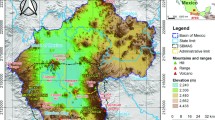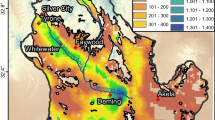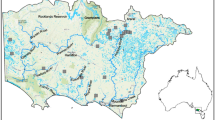Abstract
Introducing the time variable in groundwater vulnerability assessment is an innovative approach to study the evolution of contamination by non-point sources and to forecast future trends. This requires a determination of the relationship between temporal changes in groundwater contamination and in land use. Such effort will enable breakthrough advances in mapping hazardous areas, and in assessing the efficacy of land-use planning for groundwater protection. Through a Bayesian spatial statistical approach, time-dependent vulnerability maps are derived by using hydrogeological variables together with three different time-dependent datasets: population density, high-resolution urban survey, and satellite QuikSCAT (QSCAT) data processed with the innovative dense sampling method (DSM). This approach is demonstrated extensively over the Po Plain in Lombardy region (northern Italy). Calibrated and validated maps show physically consistent relations between the hydrogeological variables and nitrate trends. The results indicate that changes of urban nitrate sources are strongly related to groundwater deterioration. Among the different datasets, QSCAT-DSM is proven to be the most efficient dataset to represent urban nitrate sources of contamination, with major advantages: a worldwide coverage, a continuous decadal data collection, and an adequate resolution without spatial gaps. This study presents a successful approach that, for the first time, allows the inclusion of the time dimension in groundwater vulnerability assessment by using innovative satellite remote sensing data for quantitative statistical analyses of groundwater quality changes.
Résumé
L’introduction de la variabilité temporelle dans l’évaluation de la vulnérabilité des eaux souterraines est une approche innovante pour étudier l’évolution de la contamination diffuse et pour prédire les tendances évolutives dans le futur. Cela nécessite de déterminer la relation entre les changements au cours du temps de la contamination des eaux souterraines et de l’occupation des sols. Un tel effort permet des avancées significatives dans la cartographie des zones à risques et dans l’évaluation de l’efficacité de la planification de l’occupation des sols pour la protection des eaux souterraines. A partir d’une approche d’analyse spatiale et statistique Bayésienne, des cartes de vulnérabilité dépendantes du temps sont dérivées en utilisant des variables hydrogéologiques ainsi que trois jeux de données dépendantes du temps : la densité de population, une investigation de haute résolution des zones urbaines et des données satellites QuikSCAT (QSCQT) traitées avec la méthode innovante d’échantillonnage dense (DSM). Cette approche est appliquée de manière extensive sur la plaine du Po dans la région de La Lombardie (Nord de l’Italie). Des cartes calibrées et validées montrent des relations physiques cohérentes entre les variables hydrogéologiques et les tendances de nitrates. Les résultats indiquent que des modifications dans les sources urbaines de nitrates sont fortement reliées à la détérioration des eaux souterraines. Parmi les différents jeux de données, QSCAT-DSM s’est avéré le jeu de données le plus efficace pour représenter les sources urbaines de contamination en nitrates avec les principaux avantages suivants: une couverture mondiale, une collecte de données continues décadaires, et une résolution adéquate sans absence de données au niveau spatiale. Cette étude présente une approche réussie qui, pour la première fois, permet l’introduction de la dimension temporelle dans l’évaluation de la vulnérabilité des eaux souterraines en utilisant des données satellitaires innovantes pour l’analyse statistique quantitative des modifications de la qualité des eaux souterraines.
Resumen
La introducción de la variable tiempo en la evaluación de la vulnerabilidad del agua subterránea es un enfoque innovador para estudiar la evolución de la contaminación por fuentes no puntuales y para predecir las futuras tendencias. Esto requiere una determinación de la relación entre los cambios temporales en la contaminación del agua subterránea y en el uso de la tierra. Tal esfuerzo permitirá progresos en los avances del mapeo de áreas peligrosas y en la evaluación de la planificación del uso de la tierra para la protección del agua subterránea. A través de un enfoque estadístico espacial bayesiano, los mapas de vulnerabilidad dependientes del tiempo se derivan usando variables hidrogeológicas junto con tres conjuntos de datos diferentes dependientes del tiempo: densidad de la población, relevamientos urbanos de alta resolución, y datos de satélites QuikSCAT (QSCAT) procesados con el innovador método de muestreo de densidad (DSM). Se demuestra exhaustivamente a través de la planicie del Po en la región de Lombardía (norte de Italia). Los mapas calibrados y validados muestran relaciones físicamente consistentes entre las variables hidrogeológicas y las tendencias de los nitratos. Los resultados indican que los cambios de fuentes de nitratos urbanas están fuertemente relacionados con el deterioro del agua subterránea. Entre los diferentes conjuntos de datos, se prueba que QSCAT-DSM es el conjunto de datos más eficientes para representar las fuentes urbanas de contaminación de nitratos, siendo las principales ventajas: una cobertura mundial, una colección continua de datos decádicos, y una adecuada resolución espacial sin vacíos espaciales. Este estudio presenta un enfoque exitoso que, por primera vez, permite la inclusión de la dimensión del tiempo en la evaluación de la vulnerabilidad del agua subterránea por el uso innovador de datos satelitales de sensores remotos para el análisis estadístico cuantitativo de los cambios de la calidad del agua subterránea.
摘要
在地下水脆弱性评价中引入时间变量是研究非点源污染演化及预测未来趋势的一个创新方法。这就要求确定地下水污染和土地利用时间变化之间的关系。这种努力能够使危险区域编图和为地下水保护而进行的土地利用规划效率评价取得突破性进展。通过贝叶斯空间统计方法,利用水文地质变量加上三个不同的时间相依数据集---人口密度、高分辨率城市勘测和用创新的密集采样方法处理的卫星QuikSCAT数据---得出时间相依脆弱性图。这种方法已在(意大利北部)Lombardy地区Po平原广泛使用。校正过和验证过的图件显示水文地质变量和硝酸盐趋势之间的关系具有一致性。结果表明,城市的硝酸盐源变化和地下水的恶化有很大关联。在不同的数据集中,QSCAT-DSM证明是代表城市硝酸盐污染源最有效的数据集,主要优点是:覆盖全世界、连续十年的数据收集及无空间缺口的足够分辨率。本研究首次展示了一个成功的方法,这个方法就是能够使利用卫星遥感数据进行地下水脆弱性评价中包含时间维度,以对地下水质变化进行定量统计分析。
Resumo
A introdução da variabilidade temporal na avaliação da vulnerabilidade das águas subterrâneas é uma abordagem inovadora para o estudo da evolução da contaminação por fontes difusas e para prever tendências futuras. Isso requer uma determinação da relação entre alterações temporais na contaminação das águas subterrâneas e no uso do solo. Tal esforço permitirá avanços inovadores em áreas de mapeamento de risco, e na avaliação da eficácia do planeamento do uso do solo para a proteção das águas subterrâneas. Através de uma abordagem estatística espacial Bayesiana, são derivados mapas de vulnerabilidade dependentes do tempo usando variáveis hidrogeológicas em conjunto com três diferentes séries de dados dependentes do tempo: densidade populacional, pesquisa urbana de alta resolução e dados processados pelo satélite QuikSCAT (QSCAT) com o inovador Método de Amostragem Denso (MAD). Essa abordagem é extensamente demonstrada sobre a Planície do Pó, na região da Lombardia (norte de Itália). Mapas calibrados e validados mostram relações fisicamente consistentes entre as variáveis hidrogeológicas e as tendências de nitrato. Os resultados indicam que as mudanças nas origens urbanas do nitrato estão fortemente relacionadas com a deterioração das águas subterrâneas. Entre os diferentes conjuntos de dados, o QSCAT-DSM provou ser o conjunto de dados mais eficiente para representar fontes de contaminação urbanas de nitrato, com grandes vantagens: a cobertura mundial, a recolha de dados contínua ao longo de décadas, e uma resolução adequada, sem lacunas espaciais. Este estudo apresenta uma abordagem bem sucedida que, pela primeira vez, permite a inclusão da dimensão temporal na avaliação da vulnerabilidade das águas subterrâneas através do uso de dados de deteção remota recolhidos por um satélite inovador, para análises estatísticas quantitativas de alterações da qualidade das águas subterrâneas.












Similar content being viewed by others
References
Al Saud M (2010) Mapping potential areas for groundwater storage in Wadi Aurnah Basin, western Arabian Peninsula, using remote sensing and geographic information system techniques. Hydrogeol J 18(6):1481–1495. doi:10.1007/s10040-010-0598-9
Alberti L, De Amicis M, Masetti M, Sterlacchini S (2001) Bayes’ rule and GIS for evaluating sensitivity of groundwater to contamination. In: Proceedings of the International IAMG Conference, Cancun, Mexico, September 2001
Aller L, Bennet T, Lehr JH, Petty RJ (1987) DRASTIC: a standardised system for evaluating groundwater pollution potential using hydrologic settings. US EPA Report, 600/2–87/035, “Robert S. Kerr” Environmental Research Laboratory, Ada, OK
Anderson M, Woessner W (1992) Applied groundwater modeling: simulation of flow and advection transport. Academic, San Diego
Bonham-Carter GF (1994) Geographic information systems for geoscientists: modelling with GIS. Pergamon, New York
Brunner P, Hendricks Franssen H-J, Kgotlhang L, Bauer-Gottwein P, Kinzelbach W (2007) How can remote sensing contribute in groundwater modeling? Hydrogeol J 15(1):5–18. doi:10.1007/s10040-006-0127-z
Cowan N (2001) The magical number 4 in short-term memory: a reconsideration of mental storage capacity. Behav Brain Sci 24:87–185. doi:10.1017/S0140525X01003922
Doerfliger N, Zwahlen F (1997) EPIK: a new method for outlining of protection areas in karst environment. In: Günay G, Johnson I (ed) Proceedings 5th International symposium and field seminar on karst waters and environmental impacts, Antalya, Turkey. Balkema, Rotterdam, The Netherlands, pp 117–123
EEA (European Environment Agency) (2006) Urban sprawl in Europe: the ignored challenge (EEA report no. 10/2006). Office for Official Publications of the European Communities, Luxembourg, no. 56, pp 1725–9177
Eckardt DA, Stackelberg PE (1995) Relation of groundwater quality to land use on Long Island, New York. Ground Water 33(6):1019–1033
ERSAF (Ente Regionale per i Servizi all’Agricoltura e alle Foreste) (2014) DUSAF (Destinazione d’Uso dei Suoli Agricoli e forestali) [Land use database]. http://www.cartografia.regione.lombardia.it/. Accessed 30 January 2014
ESRI (Environmental Systems Research Institute) (2008) ArcGIS Desktop 9.3, Redlands, CA. http://www.esri.com/software/arcgis/arcgis-for-desktop. Accessed 14 January 2014
EuroGeoSurveys (2014) Water Resources. http://www.eurogeosurveys.org/topics/water-resources. Accessed 30 July 2014
European Community (1991) Council Directive 91/676/EEC concerning the protection of waters against pollution caused by nitrates from agricultural sources (Nitrate Directive). Off J Eur Comm 375:1–8
European Community (2006) Directive 2006/118/EC on the protection of groundwater against pollution and deterioration (Groundwater Directive). Off J Eur Comm 372:19–31
Focazio MJ, Reilly TE, Rupert MG, Helsel DR (2002) Assessing ground-water vulnerability to contamination: providing scientifically defensible information for decision makers. US Geol Surv Circ 1224
Foster SSD (1987) Fundamental concepts in aquifer vulnerability, pollution risk and protection strategy. In: Duijvenbooden W van, Waegeningh HG van (eds) Vulnerability of soil and groundwater to pollutants. NOASR TNO, Delft, The Netherlands, pp 69–86
Frappart F, Papa F, Güntner A, Werth S, Santos da Silva J, Tomasella J, Seyler F, Prigent C, Rossow WB, Calmant S, Bonnet M-P (2011) Satellite-based estimates of groundwater storage variations in large drainage basins with extensive floodplains. Remote Sens Environ 115(6):1588–1594. doi:10.1016/j.rse.2011.02.003
ISTAT (Istituto di Statistica Applicata al Territorio) (2001) 14° general population and housing census. http://dawinci.istat.it/. Accessed 19 March 2013
ISTAT (Istituto di Statistica Applicata al Territorio) (2011) 15° general population and housing census. http://www.istat.it/. Accessed 19 March 2013
Jasmin I, Mallikarjuna P (2011) Review: Satellite-based remote sensing and geographic information systems and their application in the assessment of groundwater potential, with particular reference to India. Hydrogeol J 19(4):729–740. doi:10.1007/s10040-011-0712-7
Jha MK, Chowdary VM (2007) Challenges of using remote sensing and GIS in developing nations. Hydrogeol J 15(1):197–200. doi:10.1007/s10040-006-0117-1
Jha MK, Chowdary VM, Chowdhury A (2010) Groundwater assessment in Salboni Block, West Bengal (India) using remote sensing, geographical information system and multi-criteria decision analysis techniques. Hydrogeol J 18(7):1713–1728. doi:10.1007/s10040-010-0631-z
Kuroda K, Fukushi T (2008) Groundwater contamination in urban areas. In: Takizawa S (ed) Groundwater management in Asian cities. Springer, Heidelberg, Germany, pp 125–149
Masetti M, Poli S, Sterlacchini S (2007) The use of the weights-of-evidence modeling technique to estimate the vulnerability of groundwater to nitrate contamination. Nat Resour Res 16(2):109–119. doi:10.1007/s11053-007-9045-6
Masetti M, Poli S, Sterlacchini S, Beretta GP, Facchi A (2008) Spatial and statistical assessment of factors influencing nitrate contamination in groundwater. J Environ Manage 86(1):272–281. doi:10.1016/j.jenvman.2006.12.023
Masetti M, Sterlacchini S, Ballabio C, Sorichetta A, Poli S (2009) Influence of threshold value in the use of statistical methods for groundwater vulnerability assessment. Sci Total Environ 407(12):3836–3846. doi:10.1016/j.scitotenv.2009.01.055
Masetti M, Nghiem SV, Sorichetta A, Stevenazzi S, Bonfanti M, Conforto A, Fabbri P, Filippini M, Gargini A, Hall D, Linard C, Pola M, Richter A, Catani F, Paloscia S, Pampaloni P, Santi E (2014) The Po plain experiment (POPLEX) field campaign: effects of urban sprawl on environmental matrices in northern Italy. Rend Online Soc Geol It 31(1):531
Nghiem SV, Leshkevich GA, Stiles BW (2004) Wind fields over the Great Lakes measured by the SeaWinds scatterometer on the QuikSCAT satellite. J Great Lakes Res 30(1):148–165
Nghiem SV, Balk D, Rodriguez E, Neumann G, Sorichetta A, Small C, Elvidge CD (2009) Observations of urban and suburban environments with global satellite scatterometer data. ISPRS J Photogramm Remote Sens 64(4):367–380. doi:10.1016/j.isprsjprs.2009.01.004
Nghiem SV, Masetti M, Stevenazzi S, Bonfanti M, Conforto A, Filippini M, Fabbri P, Pola M, Sorichetta A, Linard C, Pampaloni P, Palocia S, Santi E, Catini F, Neumann G (2014a) Interdisciplinary study of urbanization and impacts: The POPLEX 2014 Field Campaign, AGU Fall Meeting, San Francisco, December 2014
Nghiem SV, Sorichetta A, Elvidge CD, Small C, Balk D, Deichmann U, Neumann G (2014b) Remote sensing of urban environments: the Beijing case study. In: Njoku E (ed) Encyclopedia of remote sensing, Springer, Heidelberg, Germany, pp 869–878
Nolan BT (2001) Relating nitrogen sources and aquifer susceptibility to nitrate in shallow ground waters of the United States. Ground Water 39(2):290–299
Nolan BT, Hitt KJ, Ruddy BC (2002) Probability of nitrate contamination of recently recharged groundwaters in the conterminous United States. Environ Sci Technol 36(10):2138–2145. doi:10.1021/es0113854
Raines GL (1999) Evaluation of weights of evidence to predict epithermal-gold deposits in the Great Basin of the Western United States. Nat Resour Res 8(4):257–276
Raines GL, Bonham-Carter GF, Kamp L (2000) Predictive probabilistic modeling using ArcView GIS. ArcUser 3(2):45–48
Regione Lombardia, Eni Divisione Agip (2001) Geologia degli acquiferi Padani della Regione Lombardia [Geology of the Po Valley aquifers in Lombardy Region]. S.EL.CA., Florence, Italy
Sawatzky DL, Raines GL, Bonham-Carter GF, Looney CG (2009) Spatial Data Modeller (SDM): ArcMAP 9.3 geoprocessing tools for spatial data modelling using weights of evidence, logistic regression, fuzzy logic and neural networks. http://arcscripts.esri.com/details.asp?dbid=15341. Accessed 14 January 2014
Sener E, Davraz A (2013) Assessment of groundwater vulnerability based on a modified DRASTIC model, GIS and an analytic hierarchy process (AHP) method: the case of Egirdir Lake basin (Isparta, Turkey). Hydrogeol J 21(3):701–714. doi:10.1007/s10040-012-0947-y
Sorichetta A (2011) Groundwater vulnerability assessment using statistical methods. Università degli Studi di Milano, Academic year 2010, 141 pp. http://hdl.handle.net/2434/152913. Accessed 17 November 2014
Sorichetta A, Masetti M, Ballabio C, Sterlacchini S, Beretta GP (2011) Reliability of groundwater vulnerability maps obtained through statistical methods. J Environ Manage 92(4):1215–1224. doi:10.1016/j.jenvman.2010.12.009
Sorichetta A, Ballabio C, Masetti M, Robinson GR Jr, Sterlacchini S (2013) A comparison of data-driven groundwater vulnerability assessment methods. Ground Water 51(6):866–879. doi:10.1111/gwat.12012
Stevenazzi S, Masetti M, Nghiem SV, Sorichetta A (2014) Use of scatterometer data in groundwater vulnerability assessment. Rend Online Soc Geol It 30:45–50. doi:10.3301/ROL.2014.10
Stuart ME, Chilton PJ, Kinniburgh DG, Cooper DM (2007) Screening for long-term trends in groundwater nitrate monitoring data. Q J Eng Geol Hydrogeol 40(4):361–376. doi:10.1144/1470-9236/07-040
Tesoriero A, Voss F (1997) Predicting the probability of elevated nitrate concentrations in the Puget Sound basin: implications for aquifer susceptibility and vulnerability. Ground Water 35(6):1029–1039
Tweed S, Leblanc M, Webb JA, Lubczynski MW (2007) Remote sensing and GIS for mapping groundwater recharge and discharge areas in salinity prone catchments, southeastern Australia. Hydrogeol J 15(1):75–96. doi:10.1007/s10040-006-0129-x
Van Stempvoort D, Evert L, Wassenaar L (1993) Aquifer vulnerability index: a GIS compatible method for groundwater vulnerability mapping. Water Qual Res J Can 18:25–37
Wang H, Guan H, Gutiérrez-Jurado HA, Simmons CT (2014) Examination of water budget using satellite products over Australia. J Hydrol 511:546–554. doi:10.1016/j.jhydrol.2014.01.076
Welch AH, Westjohn DB, Helsel DR, Wanty RB (2000) Arsenic in ground water of the United States: occurrence and geochemistry. Ground Water 38(4):589–604
Werz H, Hötzl H (2007) Groundwater risk intensity mapping in semi-arid regions using optical remote sensing data as an additional tool. Hydrogeol J 15(6):1031–1049. doi:10.1007/s10040-007-0202-0
Worrall F, Besien T (2005) The vulnerability of groundwater to pesticide contamination estimated directly from observations of presence or absence in wells. J Hydrol 303:92–107. doi:10.1016/j.jhydrol.2004.08.019
Acknowledgements
The research carried out at the Jet Propulsion Laboratory (JPL), California Institute of Technology, was supported by the National Aeronautics and Space Administration (NASA) Land-Cover and Land-Use Change (LCLUC) Program. We thank Gregory Neumann of JPL for processing satellite QSCAT-DSM data. The research carried out at the Department of Geography and Environment, University of Southampton (UK), was done in the framework of the WorldPop Project (www.worldpop.org.uk) and supported by funding from the Bill & Melinda Gates Foundation (OPP1106427, 1032350).
Author information
Authors and Affiliations
Corresponding author
Rights and permissions
About this article
Cite this article
Stevenazzi, S., Masetti, M., Nghiem, S.V. et al. Groundwater vulnerability maps derived from a time-dependent method using satellite scatterometer data. Hydrogeol J 23, 631–647 (2015). https://doi.org/10.1007/s10040-015-1236-3
Received:
Accepted:
Published:
Issue Date:
DOI: https://doi.org/10.1007/s10040-015-1236-3




